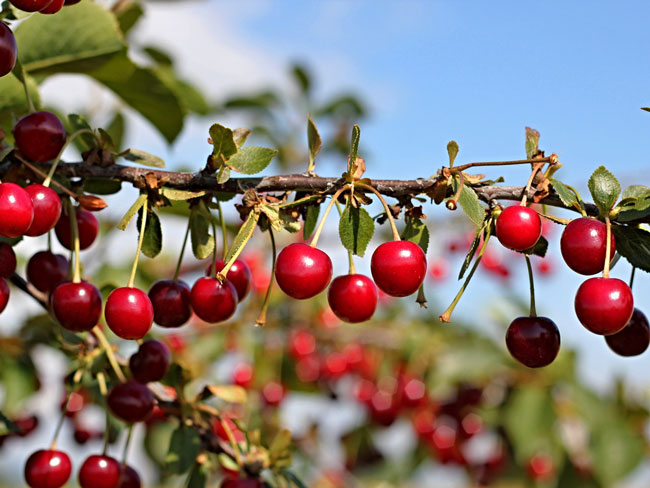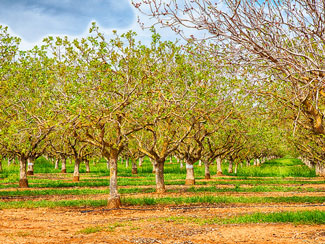Less Time to Chill
- By Pia Hinckle
- Reading Time: 6 mins.
 Cherries are finicky trees. They don’t like it when it gets too hot, when there’s not enough rain, and when it doesn’t stay cold enough during the winter. For the last few winters, California’s cherries have had all three of these environmental stresses and responded by producing fewer cherries.
Cherries are finicky trees. They don’t like it when it gets too hot, when there’s not enough rain, and when it doesn’t stay cold enough during the winter. For the last few winters, California’s cherries have had all three of these environmental stresses and responded by producing fewer cherries.
“[In 2014], we had almost no cherries—only three trees harvested on three acres,” Cindy Lashbrook of Riverdance Farms in Livingston, CA (Merced County) told The FruitGuys Magazine, “That was horrible.” She attributes the small harvest to last year’s warm temperatures. The cherries didn’t get enough “chilling hours”—temperatures below 45 degrees—which allow the tree to rest in winter and prepare for normal flower and leaf budding in the spring. “[In 2015], we didn’t have any more chilling hours, but we had more fog and more overcast, so the quality of the hours was better,” said Lashbrook, who added that this year’s crop was better but “not going to be huge.”
Times of Stress
Many of California’s fruit- and nut-bearing trees are being stressed—both by the ongoing drought and the record warm temperatures accompanying it. Historically, California has experienced a wet winter during which snow accumulates in the Sierra Nevada mountain range and acts as a water bank that slowly releases water as it melts in the spring. The last four winters have had increasingly smaller snowpacks, and the winter of 2014 provided only 6% of the long-term average snowpack—the lowest in recorded history. “The year 2014 was the warmest year across global land and ocean surfaces since records began in 1880,” according to the National Oceanic and Atmospheric Administration. California also recorded its warmest year ever in 2014.
Want farm-fresh fruit?
We've got you covered.“The last two winters have been unusually warm, and there are certain trees that really responded negatively to that—especially pistachios, cherries, and prunes,” Dr. Katherine Pope, farm advisor with UC Davis, told The FruitGuys Magazine. “Cherries took the worst hit.”
According to Pope and other scientists, California’s Central Valley has gotten warmer and will continue to get warmer according to climate change projections. “The southern end of the Central Valley is already on the tipping point for some traditional crops, some walnuts and a lot of pistachios. The current varieties—in 40 years or so—probably won’t be doing very well there because the winters will be too warm.”
 Parched
Parched
Much has been written about the catastrophic effects of the lack of precipitation on farming. Growers are choosing to opt-out of extra thirsty plants like rice, cotton, corn, and tomatoes or leaving thousands of acres fallow for lack of water. Groundwater pumping has continued to rise at an unsustainable rate as the amount of water available to farms from the state and federal water projects has been cut each year of the drought, now in its fourth year. The drought is also inspiring some farmers to experiment with new ways to grow more with less water. On April 1, 2015, California Governor Jerry Brown imposed mandatory water restrictions for businesses and residents for the first time in state history. Agriculture was excluded from the restrictions because of previous years’ cuts to its water supply. Nonetheless, the industry has come under heavy fire in the media as being wasteful, with particular crops such as almonds and broccoli being demonized as water hogs.
But consider this: In 2013, California produced nearly half of the country’s fruit and nut production (not counting citrus), 17.4 million tons valued at $2.1 billion. The state is also the world’s largest producer of almonds and pistachios and the second-largest producer of walnuts. All are at risk because of the ongoing effects of climate change.
Less Time to Chill
Nut and fruit trees (except citrus) need a specific number of hours of chill each winter in order to produce flowers in the spring that turn into fruit. The number of hours varies by species and by variety. Types with “low” chilling requirements are those that need 300 or fewer hours; “low-moderate” would be 250–400 hours; moderate 500–700; moderate-high 700–900; high is 900 and above. California’s microclimates mean that different areas will have more or less chilling hours, with the southern areas generally having less and increasing as you move north. Many large growers of stone fruit and nut trees are concentrated in the southern Central Valley.
Want fruit for your office?
Get your office a free sample TODAY!Most cherry varieties require more than 500 hours. Peaches and nectarine varieties range from as low as 100 hours for the Australian Saucer to 800 for the Double Jewel. Nectarines have a similar range, affording growers some flexibility in finding varieties that can adapt to warming climates. Pistachios need around 800 hours; walnuts from 700–1,000 hours; almonds, on the other hand, need only 300 hours.
Kevin Day, tree fruit farm advisor for UC Davis based in Tulare (King County), points out that the crops that seem to have suffered the most the last two winters are those with high chill requirements. “Bing cherries need about 700 hours and they are only getting about 500 this year. The quality of the hours makes a difference, the more fog, the better,” he told The FruitGuys Magazine.
Day says that almonds are getting a bad rap from the media as water hogs and they shouldn’t. “Almonds don’t use any more water than any other tree crop or other ag product—there are so many acres being grown, so they have a big target on its back—but they are also a huge cash crop with one of the lowest chill requirements in the state.”
 Tree Confusion
Tree Confusion
Trees can get “confused” by uneven chilling, says Day. “Chilling prevents the tree from blooming too early in the spring. But if you have an insufficient chill, the tree doesn’t know if spring is here or if it’s just warm and sunny in the middle of winter—it can get somewhat confusing, so it protects itself by blooming over a longer period of time.”
Day said that stone fruit tree growers that don’t lose crop due to lack of chill could still be affected by increased costs due to an extended blooming period: “Instead of harvesting in two or three picks, you might have to do it over four, five, or six picks over a longer period, so your labor costs will increase.”
Want farm-fresh fruit?
We've got you covered.Apricots, particularly those grown in the southern part of the Central Valley, didn’t like the conditions this winter and many trees dropped their buds, said Day. “There wasn’t a lot of numerical difference in the last two winters in terms of chilling hours, but this year we had a lot of apricot drop, but none last year. Chilling is a very complex issue—especially when we are growing on the periphery of what we consider adequate. Plant response was different this year, even if the numbers weren’t.”
The warming climate is making growers and scientists pay much closer attention to chilling. “Growers may look at varieties with less chilling requirements,” said Day. “When I was a kid, most of our varieties were 800–900 hours; now the average is 600–700 hours. We’ve made that move because those varieties are looking good, year after year.“
Jim Lucich, head of sales for Blossom Hill Apricots in Patterson, CA, said their 800 acres of apricots have done fine this winter even though they did get less chill than normal. “We had a lighter set—less fruit on the trees, but we compensate by doing less thinning,” he told The FruitGuys Magazine. “We are getting ready to pick.” He said their cherries also did well, perhaps because this winter they had more fog, which keeps the budding trees cool during the day.
Get tips for your office
Be an office hero!
Lucich said he felt that agriculture and farmers are being unfairly singled out as water wasters when their mission and livelihood depends on caring for the environment. “We were some of the first farmers with drip and micro-sprinklers—we started that years and years ago,” he said. “The media is demonizing agriculture. People don’t understand that our hearts are in giving people a healthy product, and it starts in the field and doing it correctly. Farmers like us who have been around a long time were the first environmentalists, way before others.”
Pia Hinckle is the publisher of The FruitGuys Magazine.
Recent Articles
4 Health Benefits of Eating Cherries at Work
2025 Summer Fruit Guide: What’s In Season Now?
10 Hot Employee Wellbeing Initiatives to Try in 2025
5 Creative Ways to Use Snacks for Corporate Events
Subscribe to our Newsletter
"*" indicates required fields





